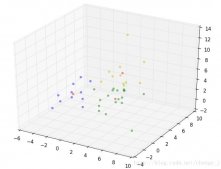最近,Analysis with Programming加入了Planet Python。作為該網站的首批特約博客,我這里來分享一下如何通過Python來開始數據分析。具體內容如下:
數據導入
導入本地的或者web端的CSV文件;
數據變換;
數據統計描述;
假設檢驗
單樣本t檢驗;
可視化;
創建自定義函數。
數據導入
這是很關鍵的一步,為了后續的分析我們首先需要導入數據。通常來說,數據是CSV格式,就算不是,至少也可以轉換成CSV格式。在Python中,我們的操作如下:
|
1
2
3
4
5
6
7
8
|
import pandas as pd # Reading data locallydf = pd.read_csv('/Users/al-ahmadgaidasaad/Documents/d.csv') # Reading data from webdata_url = "https://raw.githubusercontent.com/alstat/Analysis-with-Programming/master/2014/Python/Numerical-Descriptions-of-the-Data/data.csv"df = pd.read_csv(data_url) |
為了讀取本地CSV文件,我們需要pandas這個數據分析庫中的相應模塊。其中的read_csv函數能夠讀取本地和web數據。
數據變換
既然在工作空間有了數據,接下來就是數據變換。統計學家和科學家們通常會在這一步移除分析中的非必要數據。我們先看看數據:
|
1
2
3
4
5
6
7
8
9
10
11
12
13
14
15
16
17
18
19
20
21
|
# Head of the dataprint df.head() # OUTPUT Abra Apayao Benguet Ifugao Kalinga0 1243 2934 148 3300 105531 4158 9235 4287 8063 352572 1787 1922 1955 1074 45443 17152 14501 3536 19607 316874 1266 2385 2530 3315 8520 # Tail of the dataprint df.tail() # OUTPUT Abra Apayao Benguet Ifugao Kalinga74 2505 20878 3519 19737 1651375 60303 40065 7062 19422 6180876 6311 6756 3561 15910 2334977 13345 38902 2583 11096 6866378 2623 18264 3745 16787 16900 |
對R語言程序員來說,上述操作等價于通過print(head(df))來打印數據的前6行,以及通過print(tail(df))來打印數據的后6行。當然Python中,默認打印是5行,而R則是6行。因此R的代碼head(df, n = 10),在Python中就是df.head(n = 10),打印數據尾部也是同樣道理。
在R語言中,數據列和行的名字通過colnames和rownames來分別進行提取。在Python中,我們則使用columns和index屬性來提取,如下:
|
1
2
3
4
5
6
7
8
9
10
11
|
# Extracting column namesprint df.columns # OUTPUTIndex([u'Abra', u'Apayao', u'Benguet', u'Ifugao', u'Kalinga'], dtype='object') # Extracting row names or the indexprint df.index # OUTPUTInt64Index([0, 1, 2, 3, 4, 5, 6, 7, 8, 9, 10, 11, 12, 13, 14, 15, 16, 17, 18, 19, 20, 21, 22, 23, 24, 25, 26, 27, 28, 29, 30, 31, 32, 33, 34, 35, 36, 37, 38, 39, 40, 41, 42, 43, 44, 45, 46, 47, 48, 49, 50, 51, 52, 53, 54, 55, 56, 57, 58, 59, 60, 61, 62, 63, 64, 65, 66, 67, 68, 69, 70, 71, 72, 73, 74, 75, 76, 77, 78], dtype='int64') |
數據轉置使用T方法,
|
1
2
3
4
5
6
7
8
9
10
11
12
13
14
15
16
17
18
19
20
21
22
23
24
|
# Transpose dataprint df.T # OUTPUT 0 1 2 3 4 5 6 7 8 9Abra 1243 4158 1787 17152 1266 5576 927 21540 1039 5424Apayao 2934 9235 1922 14501 2385 7452 1099 17038 1382 10588Benguet 148 4287 1955 3536 2530 771 2796 2463 2592 1064Ifugao 3300 8063 1074 19607 3315 13134 5134 14226 6842 13828Kalinga 10553 35257 4544 31687 8520 28252 3106 36238 4973 40140 ... 69 70 71 72 73 74 75 76 77Abra ... 12763 2470 59094 6209 13316 2505 60303 6311 13345Apayao ... 37625 19532 35126 6335 38613 20878 40065 6756 38902Benguet ... 2354 4045 5987 3530 2585 3519 7062 3561 2583Ifugao ... 9838 17125 18940 15560 7746 19737 19422 15910 11096Kalinga ... 65782 15279 52437 24385 66148 16513 61808 23349 68663 78Abra 2623Apayao 18264Benguet 3745Ifugao 16787Kalinga 16900 |
其他變換,例如排序就是用sort屬性。現在我們提取特定的某列數據。Python中,可以使用iloc或者ix屬性。但是我更喜歡用ix,因為它更穩定一些。假設我們需數據第一列的前5行,我們有:
|
1
2
3
4
5
6
7
8
9
|
print df.ix[:, 0].head() # OUTPUT0 12431 41582 17873 171524 1266Name: Abra, dtype: int64 |
順便提一下,Python的索引是從0開始而非1。為了取出從11到20行的前3列數據,我們有:
|
1
2
3
4
5
6
7
8
9
10
11
12
13
14
15
|
print df.ix[10:20, 0:3] # OUTPUT Abra Apayao Benguet10 981 1311 256011 27366 15093 303912 1100 1701 238213 7212 11001 108814 1048 1427 284715 25679 15661 294216 1055 2191 211917 5437 6461 73418 1029 1183 230219 23710 12222 259820 1091 2343 2654 |
上述命令相當于df.ix[10:20, ['Abra', 'Apayao', 'Benguet']]。
為了舍棄數據中的列,這里是列1(Apayao)和列2(Benguet),我們使用drop屬性,如下:
|
1
2
3
4
5
6
7
8
9
|
print df.drop(df.columns[[1, 2]], axis = 1).head() # OUTPUT Abra Ifugao Kalinga0 1243 3300 105531 4158 8063 352572 1787 1074 45443 17152 19607 316874 1266 3315 8520 |
axis 參數告訴函數到底舍棄列還是行。如果axis等于0,那么就舍棄行。
統計描述
下一步就是通過describe屬性,對數據的統計特性進行描述:
|
1
2
3
4
5
6
7
8
9
10
11
12
|
print df.describe() # OUTPUT Abra Apayao Benguet Ifugao Kalingacount 79.000000 79.000000 79.000000 79.000000 79.000000mean 12874.379747 16860.645570 3237.392405 12414.620253 30446.417722std 16746.466945 15448.153794 1588.536429 5034.282019 22245.707692min 927.000000 401.000000 148.000000 1074.000000 2346.00000025% 1524.000000 3435.500000 2328.000000 8205.000000 8601.50000050% 5790.000000 10588.000000 3202.000000 13044.000000 24494.00000075% 13330.500000 33289.000000 3918.500000 16099.500000 52510.500000max 60303.000000 54625.000000 8813.000000 21031.000000 68663.000000 |
假設檢驗
Python有一個很好的統計推斷包。那就是scipy里面的stats。ttest_1samp實現了單樣本t檢驗。因此,如果我們想檢驗數據Abra列的稻谷產量均值,通過零假設,這里我們假定總體稻谷產量均值為15000,我們有:
|
1
2
3
4
5
6
7
|
from scipy import stats as ss # Perform one sample t-test using 1500 as the true meanprint ss.ttest_1samp(a = df.ix[:, 'Abra'], popmean = 15000) # OUTPUT(-1.1281738488299586, 0.26270472069109496) |
返回下述值組成的元祖:
t : 浮點或數組類型
t統計量
prob : 浮點或數組類型
two-tailed p-value 雙側概率值
通過上面的輸出,看到p值是0.267遠大于α等于0.05,因此沒有充分的證據說平均稻谷產量不是150000。將這個檢驗應用到所有的變量,同樣假設均值為15000,我們有:
|
1
2
3
4
5
6
|
print ss.ttest_1samp(a = df, popmean = 15000) # OUTPUT(array([ -1.12817385, 1.07053437, -65.81425599, -4.564575 , 6.17156198]), array([ 2.62704721e-01, 2.87680340e-01, 4.15643528e-70, 1.83764399e-05, 2.82461897e-08])) |
第一個數組是t統計量,第二個數組則是相應的p值。
可視化
Python中有許多可視化模塊,最流行的當屬matpalotlib庫。稍加提及,我們也可選擇bokeh和seaborn模塊。之前的博文中,我已經說明了matplotlib庫中的盒須圖模塊功能。

|
1
2
3
|
# Import the module for plottingimport matplotlib.pyplot as plt plt.show(df.plot(kind = 'box')) |
現在,我們可以用pandas模塊中集成R的ggplot主題來美化圖表。要使用ggplot,我們只需要在上述代碼中多加一行,
|
1
2
3
|
import matplotlib.pyplot as pltpd.options.display.mpl_style = 'default' # Sets the plotting display theme to ggplot2df.plot(kind = 'box') |
這樣我們就得到如下圖表:

比matplotlib.pyplot主題簡潔太多。但是在本博文中,我更愿意引入seaborn模塊,該模塊是一個統計數據可視化庫。因此我們有:

|
1
2
3
4
|
# Import the seaborn libraryimport seaborn as sns # Do the boxplotplt.show(sns.boxplot(df, widths = 0.5, color = "pastel")) |
多性感的盒式圖,繼續往下看。

|
1
|
plt.show(sns.violinplot(df, widths = 0.5, color = "pastel")) |

|
1
|
plt.show(sns.distplot(df.ix[:,2], rug = True, bins = 15)) |

|
1
2
|
with sns.axes_style("white"): plt.show(sns.jointplot(df.ix[:,1], df.ix[:,2], kind = "kde")) |

|
1
|
plt.show(sns.lmplot("Benguet", "Ifugao", df)) |
創建自定義函數
在Python中,我們使用def函數來實現一個自定義函數。例如,如果我們要定義一個兩數相加的函數,如下即可:
|
1
2
3
4
5
6
7
|
def add_2int(x, y): return x + y print add_2int(2, 2) # OUTPUT4 |
順便說一下,Python中的縮進是很重要的。通過縮進來定義函數作用域,就像在R語言中使用大括號{…}一樣。這有一個我們之前博文的例子:
產生10個正態分布樣本,其中u=3和o.
基于95%的置信度,計算 x_bar 和 x_bar2 ;
重復100次; 然后
計算出置信區間包含真實均值的百分比
Python中,程序如下:
|
1
2
3
4
5
6
7
8
9
10
11
12
13
14
15
16
17
18
19
20
21
22
23
24
25
|
import numpy as npimport scipy.stats as ss def case(n = 10, mu = 3, sigma = np.sqrt(5), p = 0.025, rep = 100): m = np.zeros((rep, 4)) for i in range(rep): norm = np.random.normal(loc = mu, scale = sigma, size = n) xbar = np.mean(norm) low = xbar - ss.norm.ppf(q = 1 - p) * (sigma / np.sqrt(n)) up = xbar + ss.norm.ppf(q = 1 - p) * (sigma / np.sqrt(n)) if (mu > low) & (mu < up): rem = 1 else: rem = 0 m[i, :] = [xbar, low, up, rem] inside = np.sum(m[:, 3]) per = inside / rep desc = "There are " + str(inside) + " confidence intervals that contain " "the true mean (" + str(mu) + "), that is " + str(per) + " percent of the total CIs" return {"Matrix": m, "Decision": desc} |
上述代碼讀起來很簡單,但是循環的時候就很慢了。下面針對上述代碼進行了改進,這多虧了 Python專家。
|
1
2
3
4
5
6
7
8
9
10
11
12
13
14
15
16
17
18
19
|
import numpy as npimport scipy.stats as ss def case2(n = 10, mu = 3, sigma = np.sqrt(5), p = 0.025, rep = 100): scaled_crit = ss.norm.ppf(q = 1 - p) * (sigma / np.sqrt(n)) norm = np.random.normal(loc = mu, scale = sigma, size = (rep, n)) xbar = norm.mean(1) low = xbar - scaled_crit up = xbar + scaled_crit rem = (mu > low) & (mu < up) m = np.c_[xbar, low, up, rem] inside = np.sum(m[:, 3]) per = inside / rep desc = "There are " + str(inside) + " confidence intervals that contain " "the true mean (" + str(mu) + "), that is " + str(per) + " percent of the total CIs" return {"Matrix": m, "Decision": desc} |












